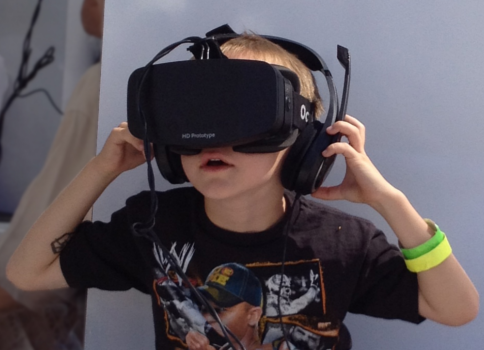
To date, VR technology—devices for simulating physical presence through sight, sound and touch—have been heavily focused on gaming, and it’s likely that gaming will remain the focus in coming years, but will expand as a media platform.
In a sign of recent growth, several developers showcased their products at CES 2015, offering the latest experiences of the new medium to the public. Leading developer Oculus VR displayed their Crescent Bay prototype of the Oculus Rift headset, as well as the Innovator Edition of the Gear VR headset for Samsung Galaxy Note 4 mobile devices. Sony also presented its Morpheus prototype, a virtual reality headset for the PlayStation 4 gaming console.
The introduction of a new consumer VR medium highlights its potential to revolutionise media accessibility, from accessible gaming to cinema, arts, television, video and web, as well as for use in research, science and medicine.
Cinema & Arts
Oculus Story Studio is a recently announced 'immersive cinema' platform, allowing the headset user to directly become part of a VR narrative. This new project shows potential for people with blindness to experience immersive storytelling through 3D sound, people with deafness to visually engage with cinema environments and people with limited mobility to experience presence in new and interesting ways.
Apps like VR Cinema and CINEVEO provide a personalised virtual movie theatre experience, replicating the environmental qualities of a real cinema for watching your own movies on a virtual screen. This immediately shows potential for people with deafness and hearing impairment to experience enabling closed captions on a cinema screen, or for people with blindness and low vision to enable an audio description track without the need for external cinema access equipment.
Riftmax Theater is an Oculus Rift supported virtual cinema app with social features enabled, paving the way for inclusive cinema experiences for people with limited physical access to theatre locations and allowing movies to be watched with friends and family via the internet.
Gaming
Oculus VR have reiterated that the Rift and Gear VR headsets are intended for seated gaming experiences first and foremost, whilst Sony’s Morpheus headset has been natively designed for the PlayStation 4 gaming console.
For gamers with blindness or vision impairment, VR experiences using 3D audio spatialisation can open up new methods of immersion using sound, gestures and touch. Oculus Rift supported games like Team Pixel Pi’s Pulse and Paavo Happonen’s Virtual Blindness reward players by focusing on environments the player can touch and hear, rather than relying on sight and visual elements to progress.
Audio & Video
Total Cinema 360 have created an Oculus Rift supported 360 degree video player, with promising developments for people with blindness or low vision, placing high priority on audio which is responsive to your current perspective.
Education
Access to arts in education through VR technology has recently been demonstrated, with Japanese headset manufacturer FOVE and the University of Tsukuba’s Special Needs Education School launching a crowdfunding initiative to distribute the Eye Play the Piano device to school children with disabilities. According to the product’s website, the head-mounted device provides an interface on which a piano can be played by ‘sight’, allowing the pianist to blink on one of the many panels within the interface to trigger the preferred note.
The use of VR in primary school education has also been shown with CSIRO’s 3P Learning bringing 3D mapped caves to classrooms, enabling Australian students to explore the Jenolan Caves via virtual reality technology.
Web
VR enabled web browsers with accessible potential are currently in development, such as JanusVR offering multiple options for control including touch, gamepads or 3D hand gestures for virtual navigation. This creates new potential and opportunities for users of assistive technology to interact and experience online environments, as well as browse traditional web pages within the medium of VR.
Potential access issues
While the technology behind VR is very much a work in progress, there are potential access issues and questions that need to be asked of developers for consumers.
If VR relies on gestures to interact, will there be alternatives for users with mobility-related impairments? How will the technology accommodate users with differing levels of vision? For hearing-impaired users, will there be support for captions or alternatives to voice interaction? How will users with cognitive-related impairments be accommodated?
Watch this space.
Further reading and research
Formal approaches to VR for access have been discussed in Lange et al’s The Potential of Virtual Reality and Gaming to Assist Successful Aging with Disability and Kamieth et al’s Exploring the Potential of Virtual Reality for the Elderly and People with Disabilities. Monash University also announced use of a 3D lab to further scientific research for their CAVE2 project in 2013.
Recent VR and Augmented Reality (AR) developments include Microsoft’s HoloLens announced at the Windows 10 event on 21 January, as well as the vision enhancement eSight headset enabling people with blindness or vision impairment to watch TV and access visual media.
The Media Access Australia website has more information on accessible cinema & arts, digital technology, web, education, TV & video and research & policy. For a comprehensive list of Oculus Rift enabled apps, visit the RiftEnabled website.
Top of page

